Mechanical Properties of a Biocomposite Based on Carbon Nanotube and Graphene Nanoplatelet Reinforced Polymers: Analytical and Numerical Study
Abstract
:1. Introduction
2. First Homogenization
2.1. Mori–Tanaka Approach
2.2. Results and Discussion
2.3. Effect of Aspect Ratio (AR)
3. Second Homogenization
3.1. Mathematical Model
3.1.1. Chamis Approach
3.1.2. Hashin–Rosen Approach
3.1.3. Halpin–Tsai Approach
- for calculation of the longitudinal modulus.
- for calculation of the transversal modulus.
3.2. Results and Discussion
4. Conclusions
- Computational and analytical models are in good agreement for aligned inclusions with enhanced mechanical properties for all volume fractions, contrary to random inclusions which are in good agreement until 10% of volume fraction.
- Due to its shape, the improved mechanical properties of the CNT matrix are in the longitudinal axis and for the GNP matrix are in the transversal axis. In addition, it is observed that CNT- and GNP-reinforced UP has enhanced mechanical properties in comparison with PP polymer for random and aligned inclusions. Additionally, the elastic properties of inclusions dominate those of polymers and fibers. The effect of aspect ratio (AR) on elastic properties has been studied, and by increasing AR from 50 to 103, increases for CNTs and, by decreasing AR from 1 to 10−4, increases for GNPs, which demonstrates that the shape of inclusions is significant
- In the 1st homogenization of aligned CNT-reinforced PP, longitudinal Young’s modulus = 152.35 GPa is greater than the random = 4.77 GPa, and transversal = 29.56 GPa is lower than . Concerning GNP-reinforced PP, transversal = 21.21 GPa is greater than the random = 13.01 GPa and = 6.98 GPa is lower than . For random inclusions, CNT- and GNP-reinforced UP has improved Young’s modulus , and for aligned inclusions, enhanced Young’s modulus is shown by CNT-UP in the axial direction (11) and GNP-UP in the transversal direction (22).
- In the 2nd homogenization, CNT-PP-reinforced alfa composite has transversely isotropic properties, and has a longitudinal Young’s modulus = 24.46 GPa close to the transversal Young’s modulus = 23.97 GPa. The in-plane Poisson’s ratio = 0.33 is close to the transverse = 0.32. For GNP-PP-reinforced Alfa, 16.22 GPa is greater than = 15.82 GPa and = 0.35 is greater than = 0.34. It is observed that the mechanical properties of the biocomposite are somewhat more favorable in the longitudinal direction than transversal because the volume fraction of the alfa fiber is 50%, and the rest is for the matrix reinforced by random CNTs and GNPs that dominate the mechanical behavior of the biocomposite.
- The alfa fibers present a promising alternative to the synthetic fibers of E-glass used in wind turbine blade fabrication because of their lightness, availability and biodegradability.
Author Contributions
Funding
Institutional Review Board Statement
Informed Consent Statement
Conflicts of Interest
References
- Tarfaoui, M.; Shah, O.R.; Nachtane, M. Design and Optimization of Composite Offshore Wind Turbine Blades. J. Energy Resour. Technol. 2019, 141. [Google Scholar] [CrossRef]
- Nachtane, M.; Tarfaoui, M.; El Moumen, A.; Saifaoui, D. Numerical Investigation of Damage Progressive in Composite Tidal Turbine for Renewable Marine Energy. In Proceedings of the 2016 International Renewable and Sustainable Energy Conference (IRSEC), Marrakech, Morocco, 14–17 November 2016; pp. 559–563. [Google Scholar]
- Nachtane, M.; Tarfaoui, M.; Goda, I.; Rouway, M. A Review on the Technologies, Design Considerations and Numerical Models of Tidal Current Turbines. Renew. Energy 2020, 157, 1274–1288. [Google Scholar] [CrossRef]
- Nachtane, M.; Tarfaoui, M.; Ait Mohammed, M.; Saifaoui, D.; El Moumen, A. Effects of Environmental Exposure on the Mechanical Properties of Composite Tidal Current Turbine. Renew. Energy 2020, 156, 1132–1145. [Google Scholar] [CrossRef]
- Belfkira, Z.; Mounir, H.; El Marjani, A. Structural Optimization of a Horizontal Axis Wind Turbine Blade Made from New Hybrid Composites with Kenaf Fibers. Compos. Struct. 2021, 260, 113252. [Google Scholar] [CrossRef]
- Boria, S.; Santulli, C.; Raponi, E.; Sarasini, F.; Tirillò, J. Evaluation of a New Green Composite Solution for Wind Turbine Blades. Multiscale Multidiscip. Model. Exp. Des. 2019, 2, 141–150. [Google Scholar] [CrossRef]
- Mekonnen, B.Y.; Mamo, Y.J. Tensile and Flexural Analysis of a Hybrid Bamboo/Jute Fiber-Reinforced Composite with Polyester Matrix as a Sustainable Green Material for Wind Turbine Blades. Int. J. Eng. 2020, 33, 314–319. [Google Scholar] [CrossRef]
- Shah, D.U.; Schubel, P.J.; Clifford, M.J. Can Flax Replace E-Glass in Structural Composites? A Small Wind Turbine Blade Case Study. Compos. Part. B Eng. 2013, 52, 172–181. [Google Scholar] [CrossRef] [Green Version]
- Huang, X.-D.; Hse, C.-Y.; Shupe, T.F. Evaluation of the Performance of the Composite Bamboo/Epoxy Laminated Material for Wind Turbine Blades Technology. BioResources 2015, 10, 660–671. [Google Scholar] [CrossRef]
- Kalagi, G.R.; Patil, R.; Nayak, N. Experimental Study on Mechanical Properties of Natural Fiber Reinforced Polymer Composite Materials for Wind Turbine Blades. Mater. Today Proc. 2018, 5, 2588–2596. [Google Scholar] [CrossRef]
- Tarfaoui, M.; El Moumen, A.; Ben Yahia, H. Damage Detection versus Heat Dissipation in E-Glass/Epoxy Laminated Composites under Dynamic Compression at High Strain Rate. Compos. Struct. 2018, 186, 50–61. [Google Scholar] [CrossRef] [Green Version]
- Tarfaoui, M.; El Moumen, A.; Lafdi, K. Progressive Damage Modeling in Carbon Fibers/Carbon Nanotubes Reinforced Polymer Composites. Compos. Part. B Eng. 2017, 112, 185–195. [Google Scholar] [CrossRef]
- Mishnaevsky, L.; Branner, K.; Petersen, H.N.; Beauson, J.; McGugan, M.; Sørensen, B.F. Materials for Wind Turbine Blades: An Overview. Materials 2017, 10, 1285. [Google Scholar] [CrossRef] [Green Version]
- Hamdan, A.; Mustapha, F.; Ahmad, K.A.; Mohd Rafie, A.S. A Review on the Micro Energy Harvester in Structural Health Monitoring (SHM) of Biocomposite Material for Vertical Axis Wind Turbine (VAWT) System: A Malaysia Perspective. Renew. Sustain. Energy Rev. 2014, 35, 23–30. [Google Scholar] [CrossRef]
- Rouway, M.; Nachtane, M.; Tarfaoui, M.; Chakhchaoui, N.; Omari, L.; Fraija, F.; Cherkaoui, O. Prediction of Mechanical Performance of Natural Fibers Polypropylene Composites: A Comparison Study. IOP Conf. Ser. Mater. Sci. Eng. 2020, 948, 012031. [Google Scholar] [CrossRef]
- Brown, K.A.; Brooks, R. Design and Analysis of Vertical Axis Thermoplastic Composite Wind Turbine Blade. Plast. Rubber Compos. 2010, 39, 111–121. [Google Scholar] [CrossRef]
- Geng, Y.; Liu, M.Y.; Li, J.; Shi, X.M.; Kim, J.K. Effects of Surfactant Treatment on Mechanical and Electrical Properties of CNT/Epoxy Nanocomposites. Compos. Part. Appl. Sci. Manuf. 2008, 39, 1876–1883. [Google Scholar] [CrossRef]
- El Moumen, A.; Tarfaoui, M.; Nachtane, M.; Lafdi, K. Carbon Nanotubes as a Player to Improve Mechanical Shock Wave Absorption. Compos. Part. B Eng. 2019, 164, 67–71. [Google Scholar] [CrossRef]
- Benyahia, H.; Tarfaoui, M.; Datsyuk, V.; El Moumen, A.; Trotsenko, S.; Reich, S. Dynamic Properties of Hybrid Composite Structures Based Multiwalled Carbon Nanotubes. Compos. Sci. Technol. 2017, 148, 70–79. [Google Scholar] [CrossRef]
- Tarfaoui, M.; Lafdi, K.; El Moumen, A. Mechanical Properties of Carbon Nanotubes Based Polymer Composites. Compos. Part. B Eng. 2016, 103, 113–121. [Google Scholar] [CrossRef]
- Nachtane, M.; Tarfaoui, M.; Ledoux, Y.; Khammassi, S.; Leneveu, E.; Pelleter, J. Experimental Investigation on the Dynamic Behavior of 3D Printed CF-PEKK Composite under Cyclic Uniaxial Compression. Compos. Struct. 2020, 247, 112474. [Google Scholar] [CrossRef]
- Naebe, M.; Abolhasani, M.M.; Khayyam, H.; Amini, A.; Fox, B. Crack Damage in Polymers and Composites: A Review. Polym. Rev. 2016, 56, 31–69. [Google Scholar] [CrossRef]
- An, Q.; Rider, A.N.; Thostenson, E.T. Electrophoretic Deposition of Carbon Nanotubes onto Carbon-Fiber Fabric for Production of Carbon/Epoxy Composites with Improved Mechanical Properties. Carbon 2012, 50, 4130–4143. [Google Scholar] [CrossRef]
- Davis, D.C.; Wilkerson, J.W.; Zhu, J.; Hadjiev, V.G. A Strategy for Improving Mechanical Properties of a Fiber Reinforced Epoxy Composite Using Functionalized Carbon Nanotubes. Compos. Sci. Technol. 2011, 71, 1089–1097. [Google Scholar] [CrossRef]
- Sassi, S.; Tarfaoui, M.; Yahia, H.B. Thermomechanical Behavior of Adhesively Bonded Joints under Out-of-Plane Dynamic Compression Loading at High Strain Rate. J. Compos. Mater. 2018, 52, 4171–4184. [Google Scholar] [CrossRef]
- Al Habis, N.; El Moumen, A.; Tarfaoui, M.; Lafdi, K. Mechanical Properties of Carbon Black/Poly (ε-Caprolactone)-Based Tissue Scaffolds. Arab. J. Chem. 2020, 13, 3210–3217. [Google Scholar] [CrossRef]
- Tarfaoui, M.; El Moumen, A.; Lafdi, K.; Hassoon, O.; Nachtane, M. Inter Laminar Failure Behavior in Laminate Carbon Nanotubes-Based Polymer Composites. J. Compos. Mater. 2018, 52, 3655–3667. [Google Scholar] [CrossRef]
- Tarfaoui, M.; Lafdi, K.; Beloufa, I.; Daloia, D.; Muhsan, A. Effect of Graphene Nano-Additives on the Local Mechanical Behavior of Derived Polymer Nanocomposites. Polymers 2018, 10, 667. [Google Scholar] [CrossRef] [Green Version]
- El Moumen, A.; Tarfaoui, M.; Lafdi, K. Computational Homogenization of Mechanical Properties for Laminate Composites Reinforced with Thin Film Made of Carbon Nanotubes. Appl. Compos. Mater. 2018, 25, 569–588. [Google Scholar] [CrossRef]
- Hassoon, O.H.; Tarfaoui, M.; El Moumen, A.; Qureshi, Y.; Benyahia, H.; Nachtane, M. Mechanical Performance Evaluation of Sandwich Panels Exposed to Slamming Impacts: Comparison between Experimental and SPH Results. Compos. Struct. 2019, 220, 776–783. [Google Scholar] [CrossRef]
- Tarfaoui, M.; El Moumen, A.; Boehle, M.; Shah, O.; Lafdi, K. Self-Heating and Deicing Epoxy/Glass Fiber Based Carbon Nanotubes Buckypaper Composite. J. Mater. Sci. 2019, 54, 1351–1362. [Google Scholar] [CrossRef]
- Shi, X.; Gholamalizadeh, E.; Moheimani, R. Applying a Micromechanics Approach for Predicting Thermal Conducting Properties of Carbon Nanotube-Metal Nanocomposites. J. Alloy. Compd. 2019, 789, 528–536. [Google Scholar] [CrossRef]
- Hassanzadeh-Aghdam, M.K.; Mahmoodi, M.J.; Jamali, J.; Ansari, R. A New Micromechanical Method for the Analysis of Thermal Conductivities of Unidirectional Fiber/CNT-Reinforced Polymer Hybrid Nanocomposites. Compos. Part. B Eng. 2019, 175, 107137. [Google Scholar] [CrossRef]
- Xiong, L.; Shuai, J.; Liu, K.; Hou, Z.; Zhu, L.; Li, W. Enhanced Mechanical and Electrical Properties of Super-Aligned Carbon Nanotubes Reinforced Copper by Severe Plastic Deformation. Compos. Part. B Eng. 2019, 160, 315–320. [Google Scholar] [CrossRef]
- Zhao, J.; Wu, L.; Zhan, C.; Shao, Q.; Guo, Z.; Zhang, L. Overview of Polymer Nanocomposites: Computer Simulation Understanding of Physical Properties. Polymer 2017, 133, 272–287. [Google Scholar] [CrossRef]
- Zeng, Q.H.; Yu, A.B.; Lu, G.Q. Multiscale Modeling and Simulation of Polymer Nanocomposites. Prog. Polym. Sci. 2008, 33, 191–269. [Google Scholar] [CrossRef]
- Bostanabad, R.; Zhang, Y.; Li, X.; Kearney, T.; Brinson, L.C.; Apley, D.W.; Liu, W.K.; Chen, W. Computational Microstructure Characterization and Reconstruction: Review of the State-of-the-Art Techniques. Prog. Mater. Sci. 2018, 95, 1–41. [Google Scholar] [CrossRef]
- Imani Yengejeh, S.; Kazemi, S.A.; Öchsner, A. Carbon Nanotubes as Reinforcement in Composites: A Review of the Analytical, Numerical and Experimental Approaches. Comput. Mater. Sci. 2017, 136, 85–101. [Google Scholar] [CrossRef]
- Chandra, Y.; Adhikari, S.; Saavedra Flores, E.I.; Figiel, Ł. Advances in Finite Element Modelling of Graphene and Associated Nanostructures. Mater. Sci. Eng. R Rep. 2020, 140, 100544. [Google Scholar] [CrossRef]
- Zhai, S.; Zhang, P.; Xian, Y.; Zeng, J.; Shi, B. Effective Thermal Conductivity of Polymer Composites: Theoretical Models and Simulation Models. Int. J. Heat Mass Transf. 2018, 117, 358–374. [Google Scholar] [CrossRef]
- Pal, G.; Kumar, S. Modeling of Carbon Nanotubes and Carbon Nanotube–Polymer Composites. Prog. Aerosp. Sci. 2016, 80, 33–58. [Google Scholar] [CrossRef]
- Ramanathan, T.; Abdala, A.A.; Stankovich, S.; Dikin, D.A.; Herrera-Alonso, M.; Piner, R.D.; Adamson, D.H.; Schniepp, H.C.; Chen, X.; Ruoff, R.S.; et al. Functionalized Graphene Sheets for Polymer Nanocomposites. Nat. Nanotechnol. 2008, 3, 327–331. [Google Scholar] [CrossRef]
- Das, B.; Prasad, K.E.; Ramamurty, U.; Rao, C.N.R. Nano-Indentation Studies on Polymer Matrix Composites Reinforced by Few-Layer Graphene. Nanotechnology 2009, 20, 125705. [Google Scholar] [CrossRef]
- Thostenson, E.T.; Chou, T.-W. On the Elastic Properties of Carbon Nanotube-Based Composites: Modelling and Characterization. J. Phys. Appl. Phys. 2003, 36, 573–582. [Google Scholar] [CrossRef]
- Hu, N.; Fukunaga, H.; Lu, C.; Kameyama, M.; Yan, B. Prediction of Elastic Properties of Carbon Nanotube Reinforced Composites. Proc. R. Soc. Math. Phys. Eng. Sci. 2005, 461, 1685–1710. [Google Scholar] [CrossRef]
- Shi, D.-L.; Feng, X.-Q.; Huang, Y.Y.; Hwang, K.-C.; Gao, H. The Effect of Nanotube Waviness and Agglomeration on the Elastic Property of Carbon Nanotube-Reinforced Composites. J. Eng. Mater. Technol. 2004, 126, 250–257. [Google Scholar] [CrossRef]
- Zhong, Y.; Kureemun, U.; Lee, H.P. Prediction of the Mechanical Behavior of Flax Polypropylene Composites Based on Multi-Scale Finite Element Analysis. J. Mater. Sci. 2017, 52, 4957–4967. [Google Scholar] [CrossRef] [Green Version]
- Jespersen, K.M.; Monastyreckis, G.; Mishnaevsky, L. On the Potential of Particle Engineered Anti-Erosion Coatings for Leading Edge Protection of Wind Turbine Blades: Computational Studies. IOP Conf. Ser. Mater. Sci. Eng. 2020, 942, 012027. [Google Scholar] [CrossRef]
- Doagou-Rad, S.; Jensen, J.S.; Islam, A.; Mishnaevsky, L. Multiscale Molecular Dynamics-FE Modeling of Polymeric Nanocomposites Reinforced with Carbon Nanotubes and Graphene. Compos. Struct. 2019, 217, 27–36. [Google Scholar] [CrossRef]
- Pontefisso, A.; Mishnaevsky, L. Nanomorphology of Graphene and CNT Reinforced Polymer and Its Effect on Damage: Micromechanical Numerical Study. Compos. Part. B Eng. 2016, 96, 338–349. [Google Scholar] [CrossRef]
- Dai, G.; Mishnaevsky, L. Graphene Reinforced Nanocomposites: 3D Simulation of Damage and Fracture. Comput. Mater. Sci. 2014, 95, 684–692. [Google Scholar] [CrossRef] [Green Version]
- Dai, G.; Mishnaevsky, L., Jr. Carbon Nanotube Reinforced Hybrid Composites: Computational Modeling of Environmental Fatigue and Usability for Wind Blades. Compos. Part. B Eng. 2015, 78, 349–360. [Google Scholar] [CrossRef] [Green Version]
- Rezaiee-Pajand, M.; Sobhani, E.; Masoodi, A.R. Semi-Analytical Vibrational Analysis of Functionally Graded Carbon Nanotubes Coupled Conical-Conical Shells. Thin-Walled Struct. 2021, 159, 107272. [Google Scholar] [CrossRef]
- Rezaiee-Pajand, M.; Sobhani, E.; Masoodi, A.R. Free Vibration Analysis of Functionally Graded Hybrid Matrix/Fiber Nanocomposite Conical Shells Using Multiscale Method. Aerosp. Sci. Technol. 2020, 105, 105998. [Google Scholar] [CrossRef]
- Rezaiee-Pajand, M.; Masoodi, A.R.; Rajabzadeh-Safaei, N. Nonlinear Vibration Analysis of Carbon Nanotube Reinforced Composite Plane Structures. Steel Compos. Struct. 2019, 30, 493–516. [Google Scholar]
- Sobhani, E.; Masoodi, A.R.; Ahmadi-Pari, A.R. Vibration of FG-CNT and FG-GNP Sandwich Composite Coupled Conical-Cylindrical-Conical Shell. Compos. Struct. 2021, 273, 114281. [Google Scholar] [CrossRef]
- Ma, P.-C.; Zhang, Y. Perspectives of Carbon Nanotubes/Polymer Nanocomposites for Wind Blade Materials. Renew. Sustain. Energy Rev. 2014, 30, 651–660. [Google Scholar] [CrossRef]
- Chu, H.; Zhang, Z.; Liu, Y.; Leng, J. Self-Heating Fiber Reinforced Polymer Composite Using Meso/Macropore Carbon Nanotube Paper and Its Application in Deicing. Carbon 2014, 66, 154–163. [Google Scholar] [CrossRef]
- Eshelby, J.D.; Peierls, R.E. The Determination of the Elastic Field of an Ellipsoidal Inclusion, and Related Problems. Proc. R. Soc. Lond. Ser. Math. Phys. Sci. 1957, 241, 376–396. [Google Scholar] [CrossRef]
- Mori and Tanaka Average Stress in Matrix and Average Elastic Energy of Materials with Misfitting Inclusions—ScienceDirect. Available online: https://www.sciencedirect.com/science/article/abs/pii/0001616073900643 (accessed on 14 January 2020).
- Chamis, C.C. Simplified Composite Micromechanics Equations for Hygral, Thermal and Mechanical Properties; NASA Glenn Research Center: Cleveland, OH, USA, 1983. [Google Scholar]
- Bacciocchi, M.; Luciano, R.; Majorana, C.; Tarantino, A.M. Free Vibrations of Sandwich Plates with Damaged Soft-Core and Non-Uniform Mechanical Properties: Modeling and Finite Element Analysis. Materials 2019, 12, 2444. [Google Scholar] [CrossRef] [Green Version]
- Tsai, S.W. Structural Behavior of Composite Materials; Philco Corporation Newport Beach California Space and Re-Entry Systems: Newport Beach, CA, USA, 1964. [Google Scholar]
- Halpin, J.C. Effects of Environmental Factors on Composite Materials; Air Force Materials Lab Wright-Patterson AFB: Dayton, OH, USA, 1969. [Google Scholar]
- Norris, A.N. An Examination of the Mori-Tanaka Effective Medium Approximation for Multiphase Composites. J. Appl. Mech. 1989, 56, 83–88. [Google Scholar] [CrossRef]
- Liu, L.; Huang, Z. A Note on Mori-Tanaka’s Method. Acta Mech. Solida Sin. 2014, 27, 234–244. [Google Scholar] [CrossRef]
- Desrumaux, F.; Meraghni, F.; Benzeggagh, M.L. Generalised Mori-Tanaka Scheme to Model Anisotropic Damage Using Numerical Eshelby Tensor. J. Compos. Mater. 2001, 35, 603–624. [Google Scholar] [CrossRef]
- Benveniste, Y. A New Approach to the Application of Mori-Tanaka’s Theory in Composite Materials. Mech. Mater. 1987, 6, 147–157. [Google Scholar] [CrossRef]
- Agarwal, B.D.; Broutman, L.J.; Chandrashekhara, K. Analysis and Performance of Fiber Composites; John Wiley & Sons: Hoboken, NJ, USA, 2006. [Google Scholar]
- Tandon, G.P.; Weng, G.J. The Effect of Aspect Ratio of Inclusions on the Elastic Properties of Unidirectionally Aligned Composites. Polym. Compos. 1984, 5, 327–333. [Google Scholar] [CrossRef]
- Mura, T. Micromechanics of Defects in Solids. In Mechanics of Elastic and Inelastic Solids, 2nd ed.; Springer: Berlin/Heidelberg, Germany, 1987; ISBN 9789024732562. [Google Scholar]
- Digimat Users’ Manual Release 2016.0. e-Xstream Engineering, MSC Software Company. Available online: www.e-Xstream.com (accessed on 14 January 2020).
- Chihi, M.; Tarfaoui, M.; Qureshi, Y.; Benyahia, H.; Bouraoui, C. Graphene Nanofillers as a Player to Improve the Dynamic Compressive Response and Failure Behavior of Carbon/Epoxy Composite. Nanotechnology 2020, 31, 425709. [Google Scholar] [CrossRef] [PubMed]
- Ximenes, F.X. Durability of Fibre Reinforced Polymer (FRP) Composite Pipe; Faculty of Engineering, University of Porto: Porto, Portugal, 2017. [Google Scholar]
- Koo, J.H. (Ed.) Basics of Polymer Matrices and Composites. In Fundamentals, Properties, and Applications of Polymer Nanocomposites; Cambridge University Press: Cambridge, UK, 2016; pp. 109–129. ISBN 9781139342766. [Google Scholar]
- Sathishkumar, T.P.; Satheeshkumar, S.; Naveen, J. Glass Fiber-Reinforced Polymer Composites—A Review. J. Reinf. Plast. Compos. 2014. [Google Scholar] [CrossRef]
- Imen, R.; Wadhah, S.; Rached, B.Y. Identification de La Loi de Comportement des Matériaux Composites à Fibres Organiques (Stipa Tenacissima L). Proc. Eng. Technol. PET 2017, 31, 37–42. [Google Scholar]
- Brahim, S.B.; Cheikh, R.B. Influence of Fibre Orientation and Volume Fraction on the Tensile Properties of Unidirectional Alfa-Polyester Composite. Compos. Sci. Technol. 2007, 67, 140–147. [Google Scholar] [CrossRef]
- Evgin, T.; Koca, H.D.; Horny, N.; Turgut, A.; Tavman, I.H.; Chirtoc, M.; Omastová, M.; Novak, I. Effect of Aspect Ratio on Thermal Conductivity of High Density Polyethylene/Multi-Walled Carbon Nanotubes Nanocomposites. Compos. Part. Appl. Sci. Manuf. 2016, 82, 208–213. [Google Scholar] [CrossRef]
- Kumar, P.; Srinivas, J. Numerical Evaluation of Effective Elastic Properties of CNT-Reinforced Polymers for Interphase Effects. Comput. Mater. Sci. 2014, 88, 139–144. [Google Scholar] [CrossRef]
- Young, R.J.; Liu, M.; Kinloch, I.A.; Li, S.; Zhao, X.; Vallés, C.; Papageorgiou, D.G. The Mechanics of Reinforcement of Polymers by Graphene Nanoplatelets. Compos. Sci. Technol. 2018, 154, 110–116. [Google Scholar] [CrossRef]
- Chamis, C.C. Thermoelastic Properties of Unidirectional Filamentary Composites by a Semiempirical Micromechanics Theory; Union Carbide Corp: Cleveland, OH, USA, 1974. [Google Scholar]
- Halpin, J.C. Stiffness and Expansion Estimates for Oriented Short Fiber Composites. J. Compos. Mater. 1969, 3, 732–734. [Google Scholar] [CrossRef]
- Tucker, C.L., III; Liang, E. Stiffness Predictions for Unidirectional Short-Fiber Composites: Review and Evaluation. Compos. Sci. Technol. 1999, 59, 655–671. [Google Scholar] [CrossRef]



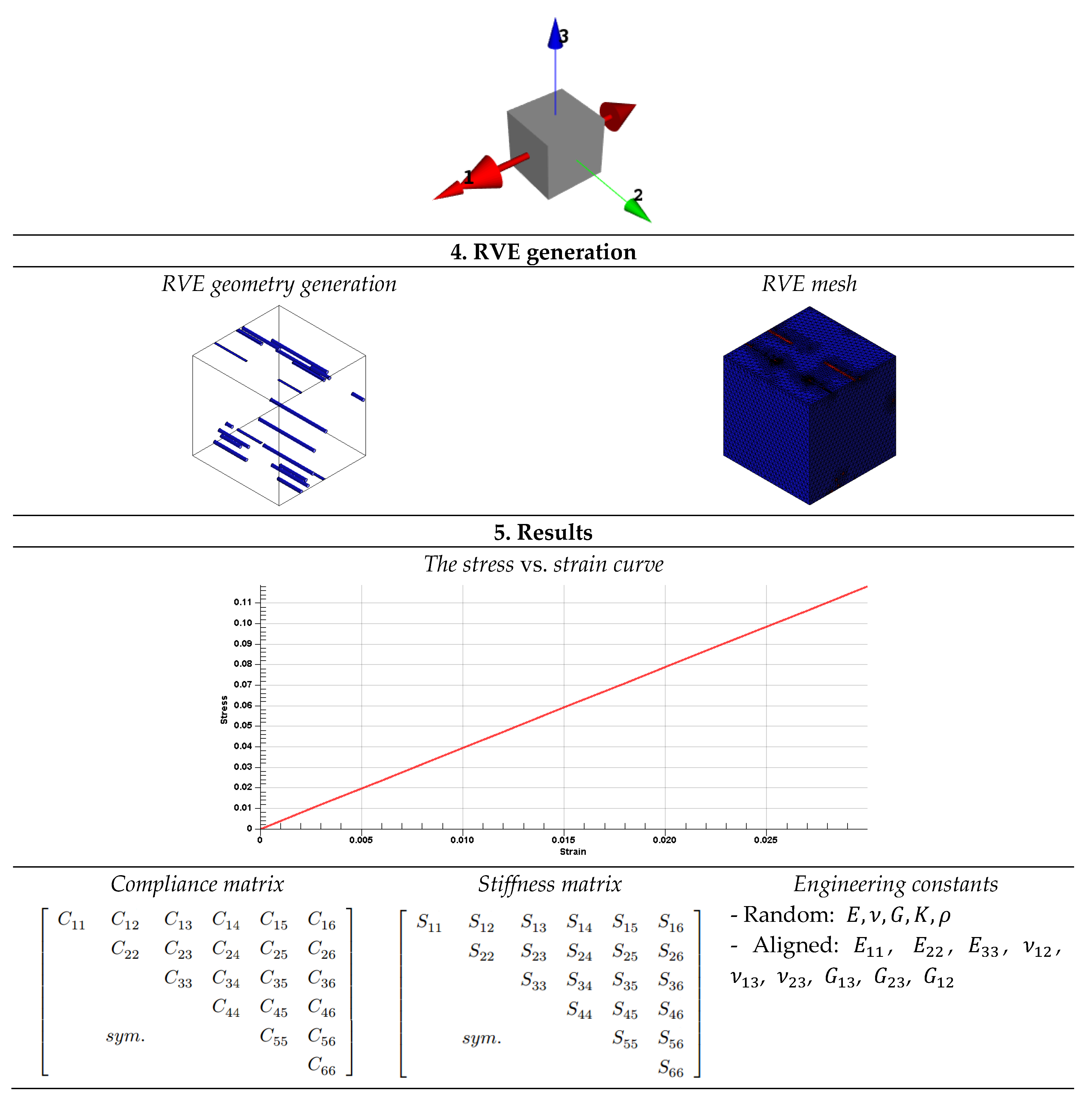

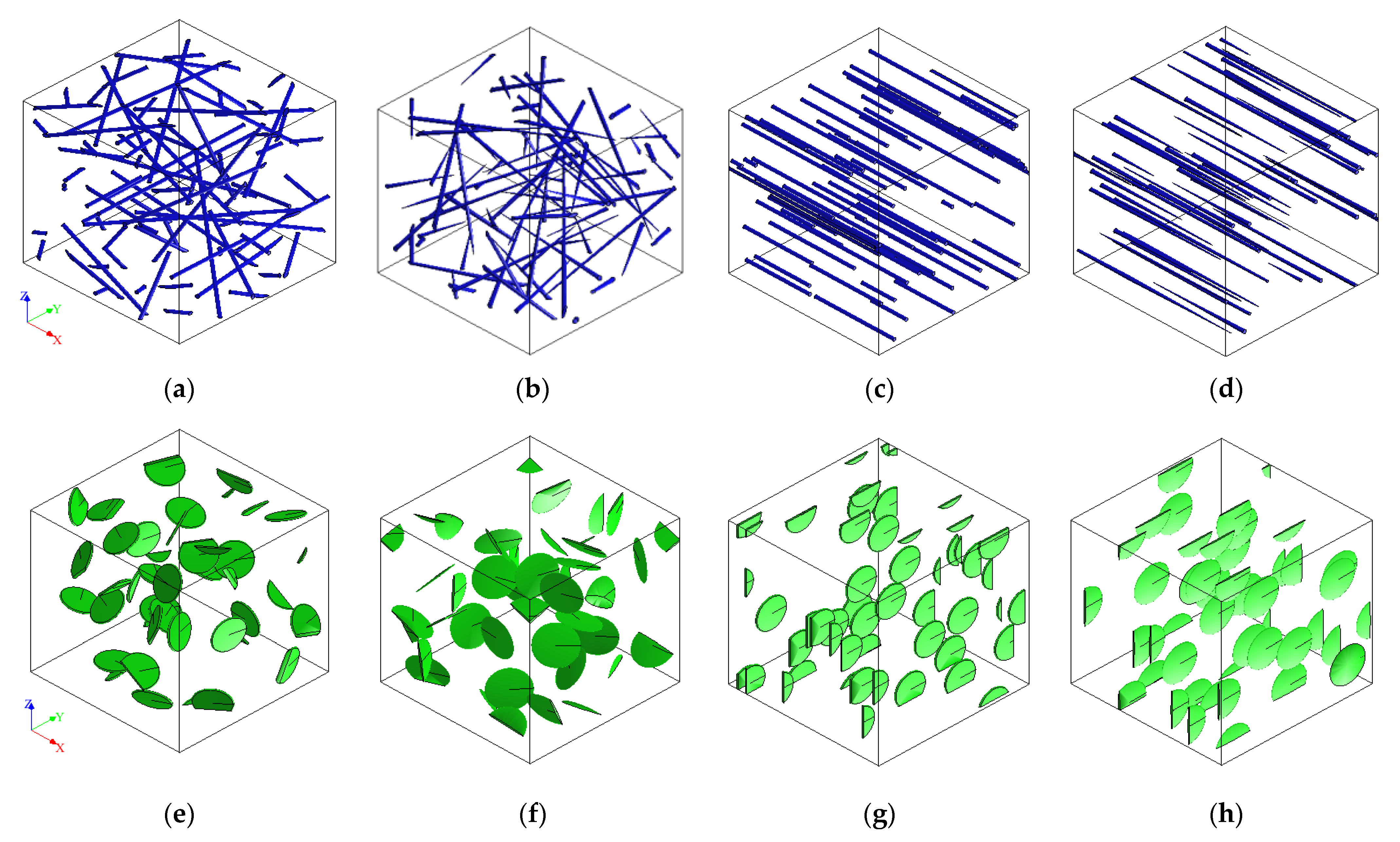
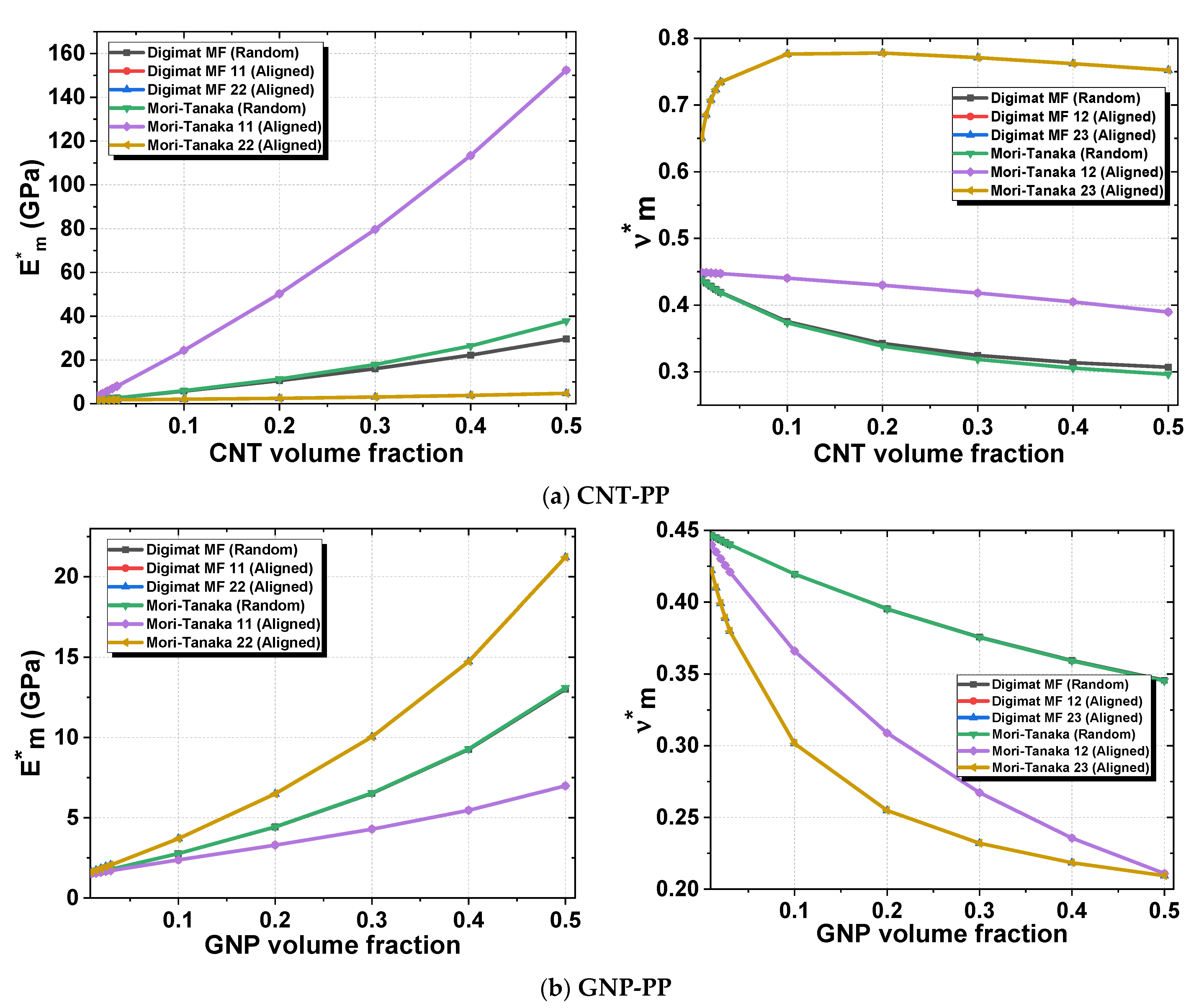


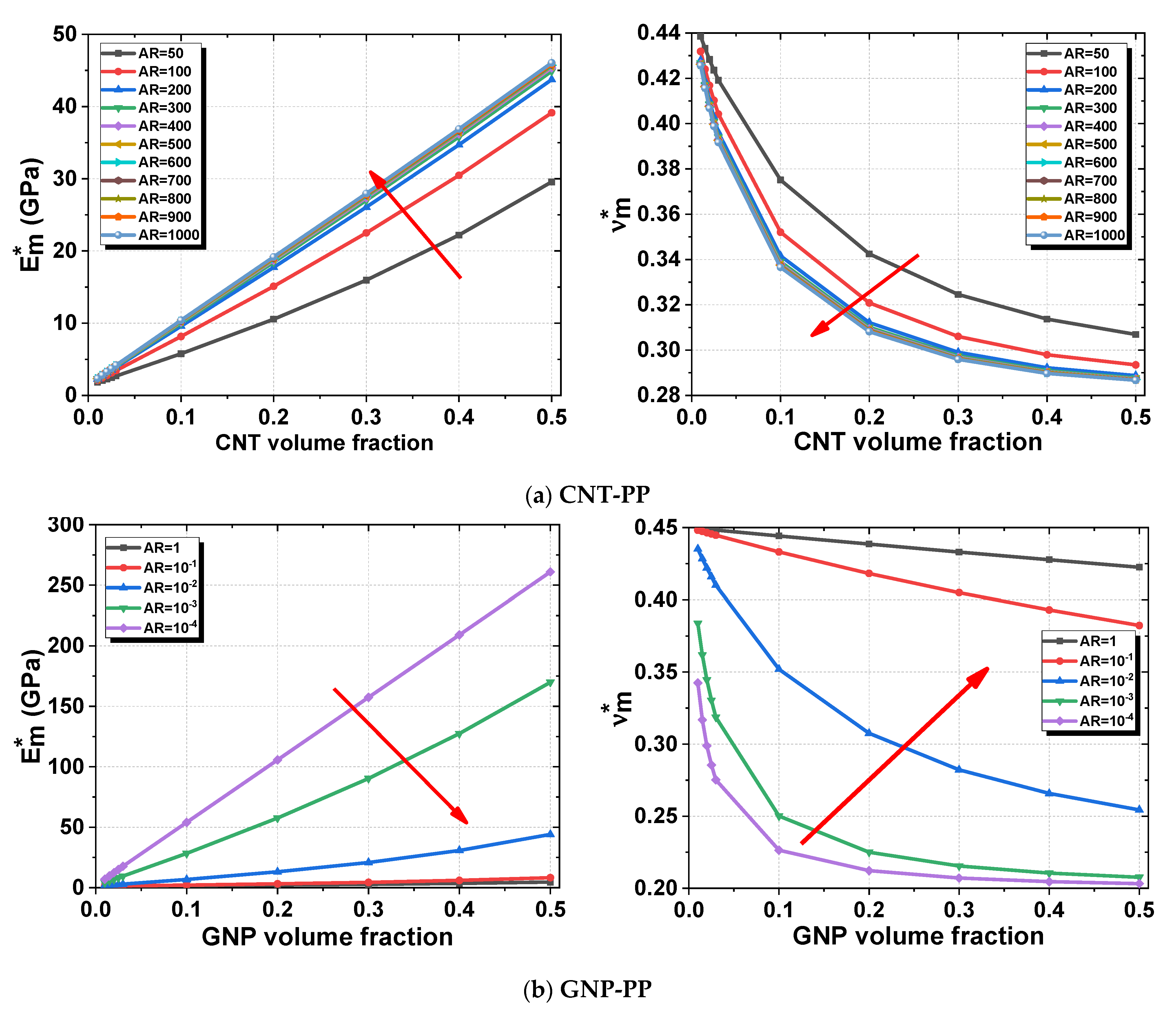



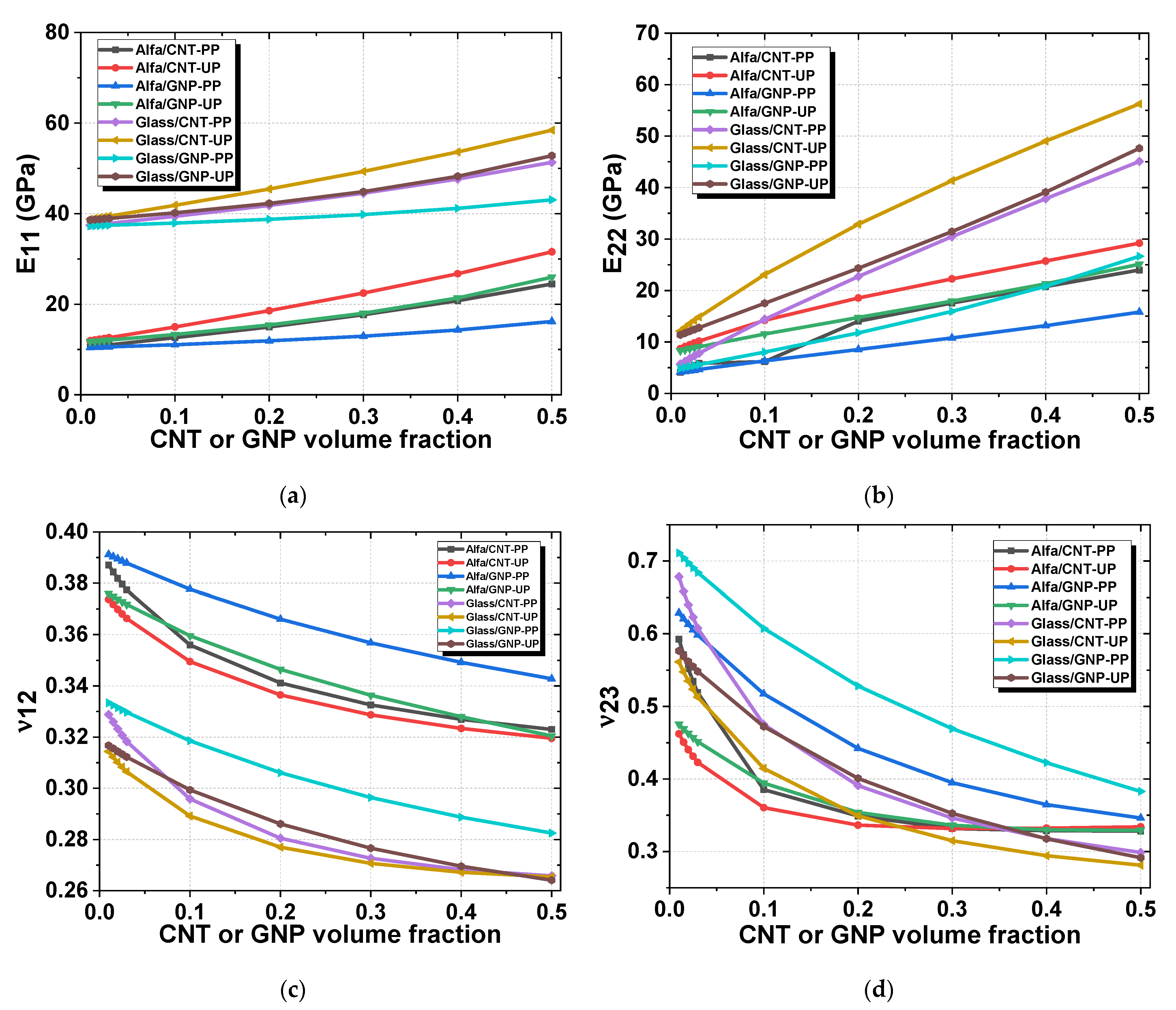
| Nanofillers [73] | Polymers [74,75] | Fibers [76,77,78] | ||||
|---|---|---|---|---|---|---|
| CNT | GNP | PP | UP | Alfa | E-Glass | |
| Density (g/cm3) | 1.2 | 2.2 | 0.9 | 1.3 | 1.52 | 2.54 |
| Young’s modulus (GPa) | 500 | 1030 | 1.4 | 3.8 | 19.4 | 73 |
| Poisson’s ratio | 0.261 | 0.19 | 0.45 | 0.42 | 0.34 | 0.23 |
| Aspect ratio | 50 | 0.05 | - | - | Continuous | Continuous |
| Young’s Modulus | Volume Fraction | 3D Random Orientation | Axial Orientation 11 | In-Plane Orientation 22 | |||||||
| Digimat FE | Digimat MF | Mori–Tanaka MT | Digimat FE | Digimat MF | Mori–Tanaka MT | Digimat FE | Digimat MF | Mori–Tanaka MT | |||
| CNT-PP | 1% | 1.58095 | 1.8283 | 1.8297 | 3.67453 | 3.57723 | 3.57723 | 1.62954 | 1.62316 | 1.62316 | |
| 1.5% | 1.93555 | 2.0425 | 2.0457 | 4.40577 | 4.67516 | 4.67516 | 1.70240 | 1.67269 | 1.67269 | ||
| 2% | 1.99163 | 2.2569 | 2.2626 | 4.87082 | 5.77938 | 5.77938 | 1.69843 | 1.71036 | 1.71036 | ||
| 2.5% | 2.49321 | 2.4715 | 2.4804 | 6.65220 | 6.88993 | 6.88993 | 1.71373 | 1.74164 | 1.74164 | ||
| 3% | 2.35354 | 2.6864 | 2.6993 | 6.77522 | 8.00688 | 8.00688 | 1.76859 | 1.76908 | 1.76908 | ||
| GNP-PP | 1% | 1.54629 | 1.5262 | 1.5262 | 1.49323 | 1.50311 | 1.50311 | 1.59839 | 1.61565 | 1.61565 | |
| 1.5% | 1.54629 | 1.5901 | 1.5901 | 1.49323 | 1.55395 | 1.55395 | 1.59839 | 1.72410 | 1.72410 | ||
| 2% | 1.63762 | 1.6545 | 1.6545 | 1.61087 | 1.60436 | 1.60436 | 1.88727 | 1.83307 | 1.83307 | ||
| 2.5% | 1.60123 | 1.7194 | 1.7194 | 1.68573 | 1.65435 | 1.65435 | 2.08842 | 1.94267 | 1.94267 | ||
| 3% | 1.73906 | 1.7849 | 1.7850 | 1.68363 | 1.70395 | 1.70395 | 2.07030 | 2.05295 | 2.05295 | ||
| Poisson ratio | Volume Fraction | 3D Random Orientation | Transverse Orientation 12 | In-Plane Orientation 23 | |||||||
| Digimat FE | Digimat MF | Mori–Tanaka MT | Digimat FE | Digimat MF | Digimat MT | Digimat FE | Digimat MF | Mori–Tanaka MT | |||
| CNT-PP | 1% | 0.44182 | 0.43847 | 0.43843 | 0.44863 | 0.44908 | 0.44908 | 0.65448 | 0.65069 | 0.65069 | |
| 1.5% | 0.40406 | 0.43320 | 0.43312 | 0.44238 | 0.44862 | 0.44862 | 0.67621 | 0.68556 | 0.68556 | ||
| 2% | 0.51008 | 0.42824 | 0.42810 | 0.44494 | 0.44816 | 0.44816 | 0.68971 | 0.70782 | 0.70782 | ||
| 2.5% | 0.48195 | 0.42354 | 0.42334 | 0.44787 | 0.44769 | 0.44769 | 0.72118 | 0.72317 | 0.72317 | ||
| 3% | 0.52998 | 0.41910 | 0.41882 | 0.44172 | 0.44722 | 0.44722 | 0.72086 | 0.73434 | 0.73434 | ||
| GNP-PP | 1% | 0.41464 | 0.44660 | 0.44660 | 0.44114 | 0.43990 | 0.43990 | 0.42285 | 0.42205 | 0.42205 | |
| 1.5% | 0.41464 | 0.44494 | 0.44493 | 0.44114 | 0.43502 | 0.43502 | 0.42285 | 0.41003 | 0.41003 | ||
| 2% | 0.44717 | 0.44329 | 0.44329 | 0.42983 | 0.43025 | 0.43025 | 0.38425 | 0.39909 | 0.39909 | ||
| 2.5% | 0.48956 | 0.44167 | 0.44166 | 0.42274 | 0.42559 | 0.42559 | 0.35891 | 0.38908 | 0.38908 | ||
| 3% | 0.46768 | 0.44006 | 0.44006 | 0.41418 | 0.42102 | 0.42102 | 0.37605 | 0.37990 | 0.37990 | ||
| Number of Elements | Effective Volume Fraction on Mesh | Effective Volume Fraction on Geometry | |
|---|---|---|---|
| Fiber | 23987 | 0.501893 | 0.502655 |
| Polymer | 30128 | 0.498107 | 0.497345 |
Publisher’s Note: MDPI stays neutral with regard to jurisdictional claims in published maps and institutional affiliations. |
© 2021 by the authors. Licensee MDPI, Basel, Switzerland. This article is an open access article distributed under the terms and conditions of the Creative Commons Attribution (CC BY) license (https://creativecommons.org/licenses/by/4.0/).
Share and Cite
Rouway, M.; Nachtane, M.; Tarfaoui, M.; Chakhchaoui, N.; Omari, L.E.H.; Fraija, F.; Cherkaoui, O. Mechanical Properties of a Biocomposite Based on Carbon Nanotube and Graphene Nanoplatelet Reinforced Polymers: Analytical and Numerical Study. J. Compos. Sci. 2021, 5, 234. https://doi.org/10.3390/jcs5090234
Rouway M, Nachtane M, Tarfaoui M, Chakhchaoui N, Omari LEH, Fraija F, Cherkaoui O. Mechanical Properties of a Biocomposite Based on Carbon Nanotube and Graphene Nanoplatelet Reinforced Polymers: Analytical and Numerical Study. Journal of Composites Science. 2021; 5(9):234. https://doi.org/10.3390/jcs5090234
Chicago/Turabian StyleRouway, Marwane, Mourad Nachtane, Mostapha Tarfaoui, Nabil Chakhchaoui, Lhaj El Hachemi Omari, Fouzia Fraija, and Omar Cherkaoui. 2021. "Mechanical Properties of a Biocomposite Based on Carbon Nanotube and Graphene Nanoplatelet Reinforced Polymers: Analytical and Numerical Study" Journal of Composites Science 5, no. 9: 234. https://doi.org/10.3390/jcs5090234
APA StyleRouway, M., Nachtane, M., Tarfaoui, M., Chakhchaoui, N., Omari, L. E. H., Fraija, F., & Cherkaoui, O. (2021). Mechanical Properties of a Biocomposite Based on Carbon Nanotube and Graphene Nanoplatelet Reinforced Polymers: Analytical and Numerical Study. Journal of Composites Science, 5(9), 234. https://doi.org/10.3390/jcs5090234










